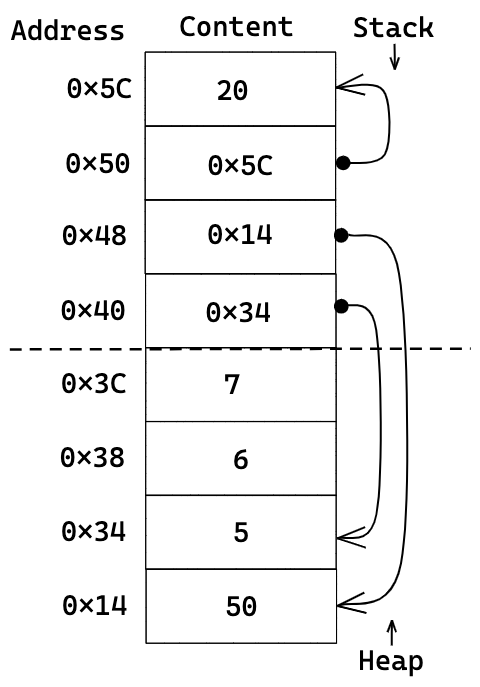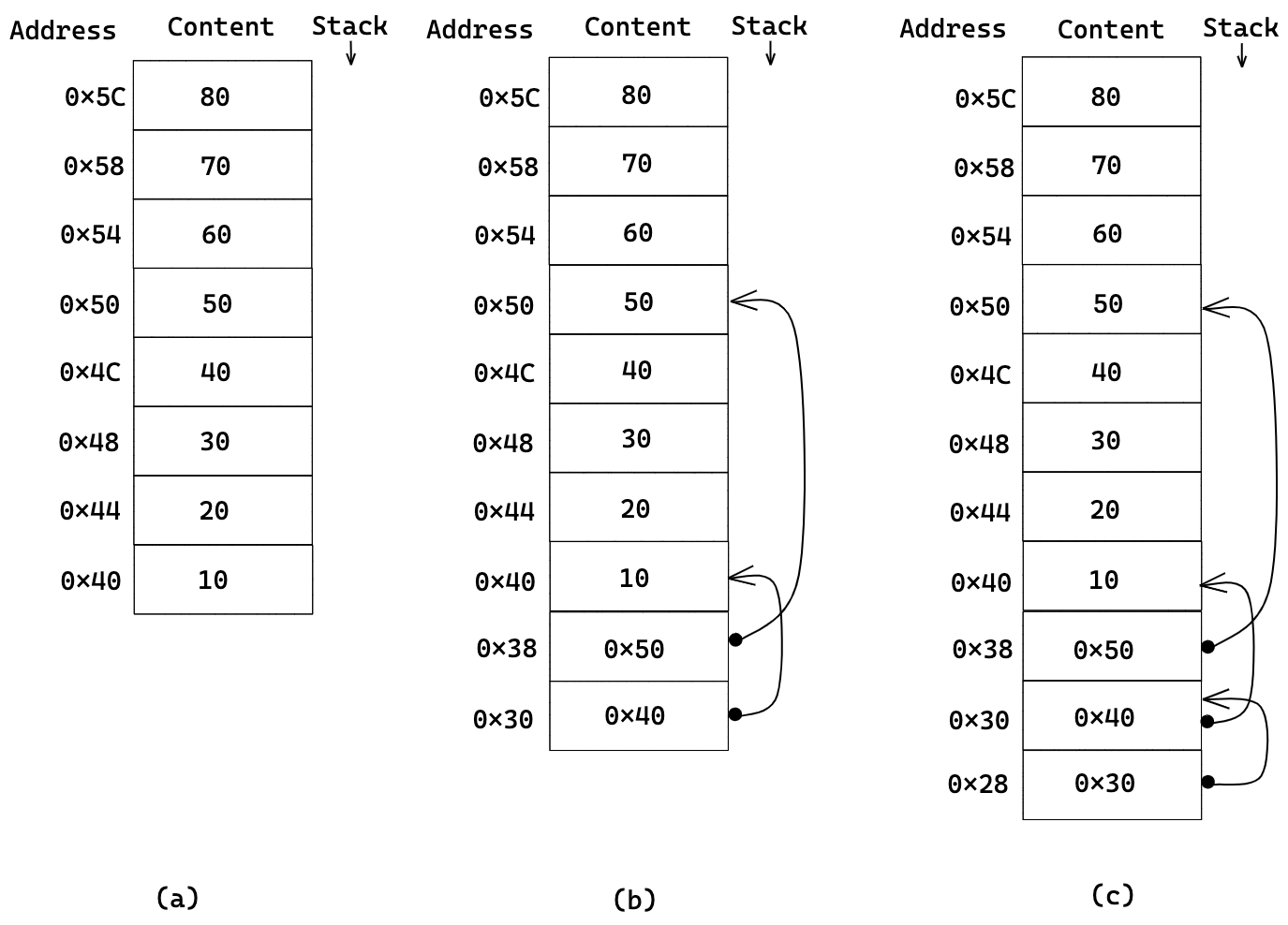1.5. C Refresher¶
For some of these questions you will need to compile and run C code.
(For others, you may find it useful to experiment with C code.)
For this section, you may use any editor and C compiler.
If you don’t have a favorite C compiler on your personal laptop or PC, you
can use the Biglab. On the Linux machines, you can compile a simple, single C file application in program.c using:
gcc -o program program.c
Following are some recommended resources for learning C:
Write the C code to reproduce the contents of the stack and heap as shown in Fig. 1.1. You can use any variable and pointer names with int type. For e.g. address
0x5Cis filled withint x = 20;. Note that the hex values shown below are not absolute and is just there as a guide. We expect location of heap and stack to be different.
Fig. 1.1 Memory space with stack and heap¶
Hint
Find out what causes things to go into stack vs heap in C. Find out how the stack and heap grow.
Use
printfto print out the value and addresses and verify whether something went into the stack or heap. You can also useprintfto figure out which direction the stack and heap are growing.Use the address values as a guide. For instance, for the addresses
0x34,0x38,0x3C, why are the differences between the addresses 4 bytes? Compared to addresses,0x40,0x48,0x50, the differences there are 8 bytes—why is that? Do the contents in those addresses tell you something about it? Why are there arrows for some boxes and not for others (the arrows are also there just to guide you)?What data structure do the contents at
0x34,0x38, and0x3Cremind you of?
The stack grows downward and the heap grows upwards (with GCC compiler and x86 architecture we are using in Biglab). What happens when stack and heap memory space collide? (4-5 lines) Your answer should include what happens when you are running your program under an OS vs when you are running in a bare-metal system.
Hint
Think of what guarantees you get in an OS vs guarantees you don’t get in a bare-metal system.
A bare-metal system will not have virtual guards on memory regions and typically omits checks for bounds on stacks and heaps.
Later in the course when we’ll use the Ultra96, we may need to increase our stack/heap size in the linker script to get the correct output in our program!
Fig. 1.2 shows the content of an 8 element int array on the stack.
Write the C code to allocate this array on the stack as shown in Fig. 1.2(a), as a 2D array.
Building from (a), declare an array of pointers as shown in Fig. 1.2(b), and use it to print out the contents of the 2D array.
Building from (b), declare a double pointer as shown in Fig. 1.2(c), and use it to print out the contents of the 2D array.
Hint
A 2D array is not equivalent to a double pointer! Review these slides.

Fig. 1.2 8 element array on the stack¶
Considering the following code, give an expression to obtain the address of
bthat can be accessed via the third element ofx. (1 line)struct s2 { float a; int b; }; struct s1 { int c; struct s2 **d; }; struct s1 x[5];
The following array will be stored as a sequence of bits in memory. We could also consider these bits as a sequence of bytes (
unsigned char). Show code that prints those bytes. Avoid needless copying or losing information. Note that an IEEE Double-precision floating-point value is stored in 64 bits. You can see https://www.geeksforgeeks.org/ieee-standard-754-floating-point-numbers/ for more information on IEEE Double-precision floating-point format, but understanding this is not necessary to your solution, only to understanding what it is your solution is reporting.double a[] = {3.14, 2.71};
Put together code to print the address associated with each of the arrays,
a,b,c, andd. Include the code and the results of running it and reporting the addresses.void temp(int i) { int a[2]; int b[3]; int *c; int *d; c = (int *)malloc(sizeof(int) * 4); d = (int *)malloc(sizeof(int) * 5); // print addresses for arrays here.... return; }
What might happen with the following code?
int a[3]; int b[4]; int c[5]; // intervening code omitted b[4]=13;
Many different things could happen. Give multiple answers. For each identified case, what happens and why (2 lines max for each case).
Compile and run the following code.
#include "stdio.h" #include "stdlib.h" int main(int argc, char** argv) { unsigned char a[3] = {0xFF, 0x01, 73}; unsigned char sum; unsigned int intsum; signed char sa[3] = {127, 1, 33}; signed char ssum; signed int sintsum; fprintf(stdout, "Unsigned:\n"); for (int i = 0; i < 3; i++) for (int j = 0; j < 3; j++) { sum = a[i] + a[j]; intsum = a[i] + a[j]; fprintf(stdout, "in decimal: %d+%d=%d (intsum=%d)\t", a[i], a[j], sum, intsum); fprintf(stdout, "in hexadecimal: %x+%x=%x (intsum=%x)\n", a[i], a[j], sum, intsum); } fprintf(stdout, "Signed:\n"); for (int i = 0; i < 3; i++) for (int j = 0; j < 3; j++) { ssum = sa[i] + sa[j]; sintsum = sa[i] + sa[j]; fprintf(stdout, "in decimal: %d+%d=%d (intsum=%d)\t", sa[i], sa[j], ssum, sintsum); fprintf(stdout, "in hexadecimal: %x+%x=%x (intsum=%x)\n", sa[i], sa[j], ssum, sintsum); } }
Explain the results you get. Why do the
charandunsigned charsums differ from the integer sums? (2-3 lines each) Why does the computer produce the specific values that it does for each of thecharandunsigned charsums? (1-3 lines each)What is the purpose of the preprocessor, compiler, and linker? (each 3 lines max.)
Potentially useful:
[We point you at the gcc documentation because it is easily available online. Many of the options and concepts are the same across other C compilers. In some cases, Xilinx tools will use gcc internally. For some of your development (including, perhaps, for this section of this assignment) you may find it useful to get your C working on a workstation, laptop, or on Biglab using gcc.]
If the preprocessor cannot find a file that is included with
#include, give at least three different ways you could resolve the problem so that the preprocessor can find the file? (1–2 lines each)Possibly useful:
If the linker gives you an error like
undefined reference to ..., identify three reasons this could occur and at least one way to resolve each. (1–2 lines each)Possibly useful:
